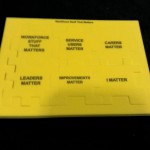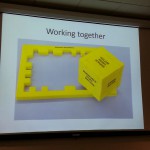
The Art of Integration
Never underestimate the power of intention.
A Commitment to Collaboration
Throughout history we have seen how health and healthcare have relied on the concepts of prevention, active participation and reciprocal relationships between professionals, service users and families – and much of today’s literature is reviving these notions into policy, strategy and frontline service delivery. Much discussion is highlighting the role that everyone can play in improving health and well-being. On a wider scale, there are commitments to work in ways that are asset-based, co-productive and person-centred.
The Power of Intention
The Scottish Government’s ambitious reform of health and social care services is currently underway; with Integration Joint Boards being established.
The vision focuses on:
- Continuously improving services that are responsive and efficient to peoples’ needs.
- Seamless working with colleagues and partner organisations.
- A commitment to safe, effective and person centred care.
- A sustainable, capable and integrated workforce.
- Effective leadership and management.
- Healthy organisational cultures.
Overall, it’s about putting people at the centre of health and care services, and in ensuring that people – at any point of their health journey – obtain the best care and support required.
Leading Integration for Quality
Many of these themes resonated at the recent NHS Scotland Event, which was held in Glasgow’s SECC, 23-24 June 2015. Now in its tenth year, the theme of the event was ‘Leading Integration for Quality’, and it focussed on improving the quality of care through joint working with partners across the public and third sectors.
The programme reflected on the achievements of the Quality Strategy (‘Quality Ambitions’ of safe, effective and person centred care), and set out visions for an integrated future. In particular, the wider UK evidence base for integration was presented, and the critical role of the workforce in delivering integrated health and social care was highlighted. In addition, a few sessions looked at the importance of reducing inequalities, the challenges and opportunities of integration, and ways of empowering everyone to live healthier lives.
With approximately 1500 health and care leaders present, 60 exhibitors, 230 posters on display, and a range of presentations and plenary sessions, there were plenty of opportunities to learn about the emerging integration landscape, and to actively contribute to better healthcare.
Here are some pictures from the event and the surrounding environment:
A Vision for Tomorrow
Scotland is at the brink of transformation: demographics are changing; innovative technologies are emerging; and new voices are surfacing. Health and social care integration aims to acknowledge these changes, and to integrate the contributions of organisations – spanning many functions, disciplines and professions – to drive improvements in the quality and consistency of health and social care services.
This requires the efficient collaboration between service users, carers, community groups, and colleagues in councils, and other statutory and voluntary sector agencies.
In summary, the art and science of greater service integration perhaps rests upon (1) an understanding of complex systems and their interlocking parts, (2) the will to deliver shared outcomes, and (3) effective leadership, communication, and collaboration.
References
Avicenna (Ib Sina) (published c. 1012-1025). The Canon of Medicine (Al Qanun fi al Tibb). Retrieved from http://www.canonofmedicine.com
Batalden, M., Batalden, P., Margolis, P., Seid, M., Armstrong, G., Opipari-Arrigan, L., & Hartung, H. (2015). Coproduction of healthcare service. BMJ Quality & Safety, bmjqs–2015–004315–. doi:10.1136/bmjqs-2015-004315
Crown Copyright. (2011). Commission on the Future Delivery of Public Services. Edinburgh: Scottish Government. Retrieved from http://www.gov.scot/Publications/2011/06/27154527/18
Crown Copyright. (2014). Public Bodies (Joint Working) (Scotland) Act 2014. UK: The Stationery Office. Retrieved from http://www.legislation.gov.uk/asp/2014/9/pdfs/asp_20140009_en.pdf
El-Farargy, N. (2015). Everyone Matters: Views, experiences and perceptions of working across sectors. The benefits of boundary spanning for health and social care. Presented at ‘the gathering’ 25-26 February 2015, SECC, Glasgow.
Scottish Co-Production Network. (2015). Scottish Co-Production Network. Retrieved December 20, 2015, from http://www.coproductionscotland.org.uk/
Scottish Government. (2010). The Healthcare Quality Strategy for NHSScotland – putting people at the heart of our NHS. Edinburgh: Scottish Government. Retrieved from http://www.gov.scot/Publications/2010/05/10102307/0
Scottish Government. (2013). Everyone Matters: 2020 Workforce Vision. Retrieved from http://www.gov.scot/Resource/0042/00424225.pdf
Scottish Government. (2015). Public Service Reform. Scottish Government. Retrieved December 20, 2015, from http://www.gov.scot/Topics/Government/PublicServiceReform
Scottish Government. (2015). NHS Scotland Event. Retrieved December 20, 2015, from http://nhsscotlandevent.com/
Further Reading
El-Farargy, N. (2015). Pedler, Mike & Abbott, Christine (2013) Facilitating action learning McGraw-Hill (Maidenhead & New York) ISBN 978-033524597-0 204 pp £19.99 http://www.mheducation.co.uk/9780335245970-emea-facilitating-action-learning-a-practitioners-guide. British Journal of Educational Technology, 46(4), E17–E18. doi:10.1111/bjet.12308_3
McMahon, A. (2015). The science and choreography of pit stops in Formula 1. Retrieved December 20, 2015, from https://www.888sport.com/insights/formula-1.htm
Copyright
Copyright © Nancy El-Farargy, 2015.
Explore More











